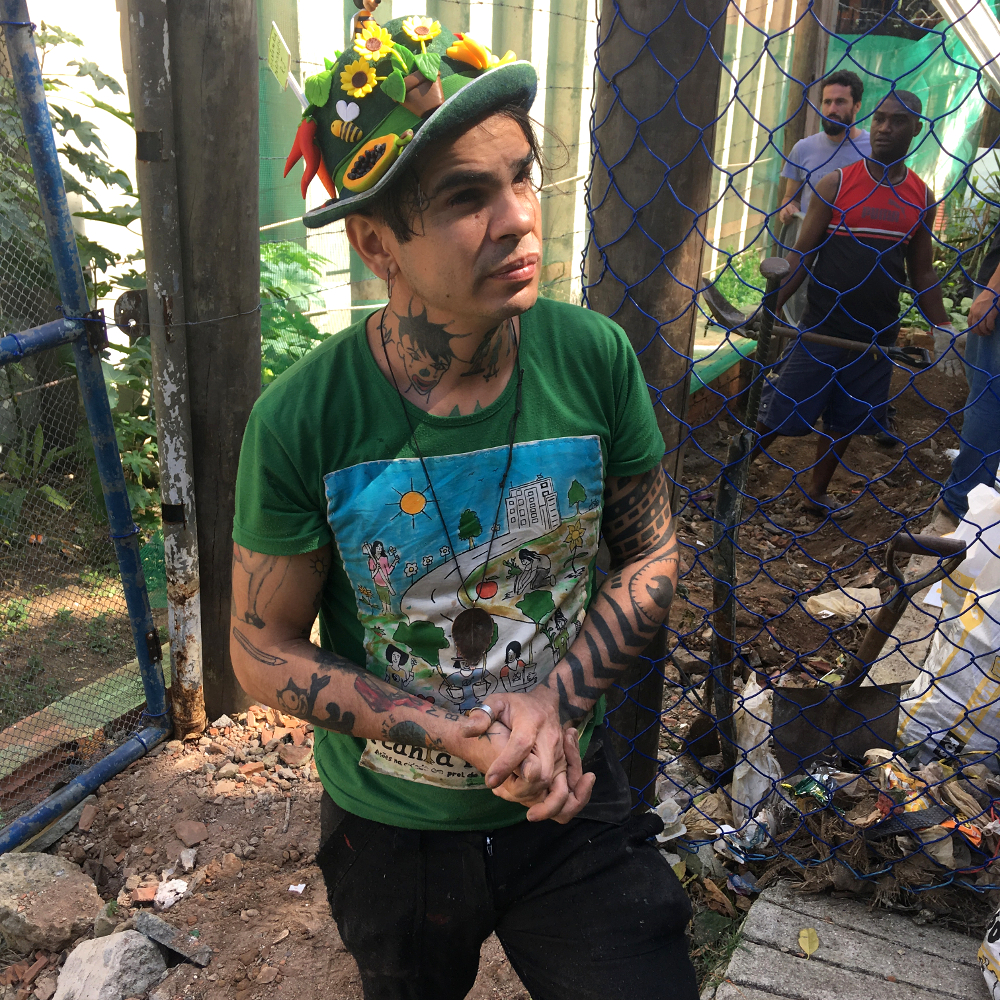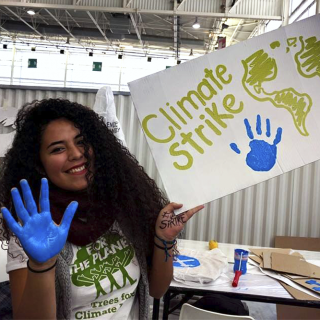Mono Telha, 37, doesn’t like to be called a leader. He’s shy when talking about himself, always directing the conversation back to the group as a whole. But, he can’t escape the truth that he’s the founder of Planta na Rua RJ, a “direct action network,” in his words, that creates and maintains urban green spaces in Rio de Janeiro.
Since 2009, when he created Planta na Rua RJ—Plant on the Street, Rio di Janeiro—the group has been responsible for roughly 100 projects, mainly in the city’s suburbs and Downtown.
Telha was born in Duque de Caxias, a city just north of Rio de Janeiro, but grew up in the metropolis itself, in the Lapa neighborhood, downtown.
Mono Telha isn’t his real name, but rather a reference to the nerd glasses he used to wear when he was young, that covered his eyebrows.
Telha, a professional gardener and self-taught ecologist, is fascinated by the environment. The idea for Planta na Rua, he told Believe.Earth, came from his experience planting gardens as a child.
“My friends and I used to do this,” he said. “Back in the suburbs, people used to plant fruit trees, like acerola cherry trees, on sidewalks. Then, as a teenager, I was a Scout, so I kept this relationship with the land and nature.”
Telha’s first organization limited its activity to the planting of fruit and vegetable gardens in empty lots. Later, the group moved on to adopting public planters and holding workshops combining ecology and activism.
By creating public green spaces, people are not only improving living conditions in the city, the Planta na Rua founder said. They’re not only helping to reverse high temperatures, address water and shade shortages and reduce noise and air pollution. Most importantly, in his view, they’re “exercising their right to the environment.”
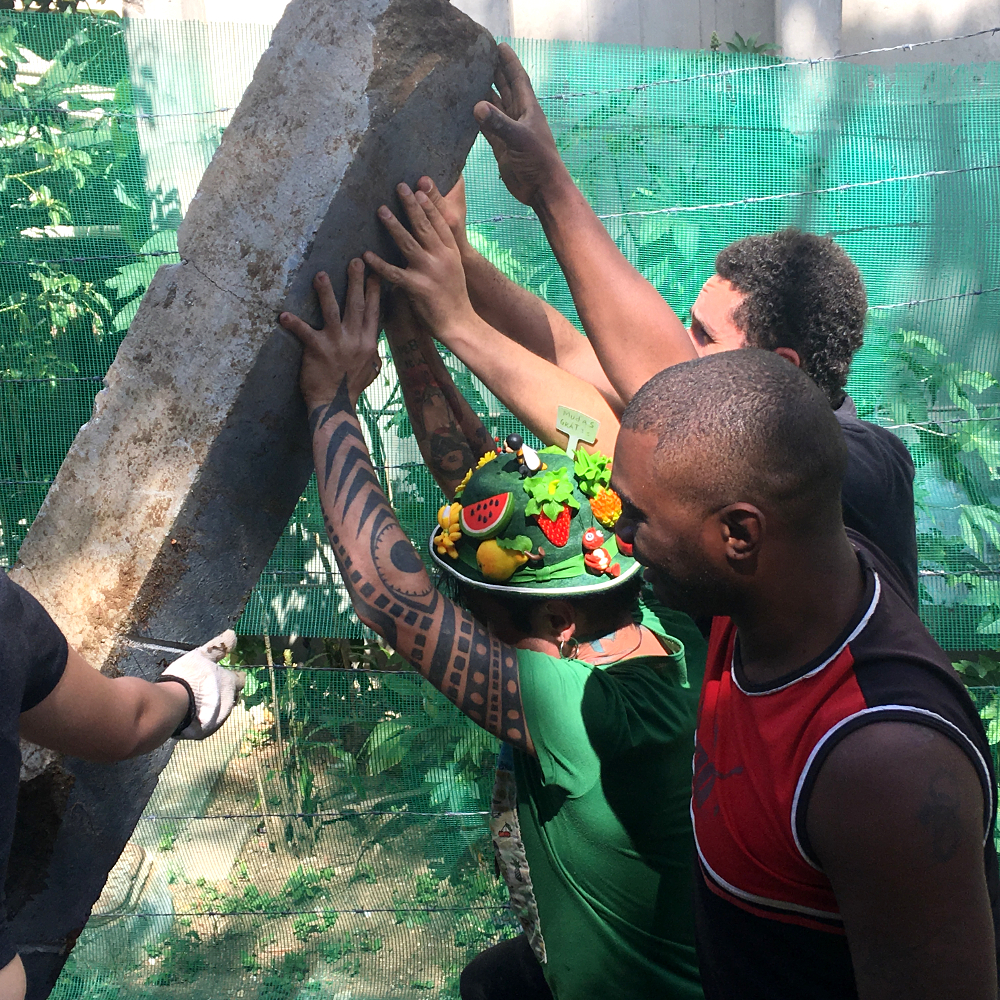
Hard work: Volunteers in Cantagalo, in southern Rio de Janeiro, cooperate to remove a concrete beam from the site of a future fruit and vegetable garden (Thiago Camelo/Believe.Earth)
HORIZONTAL MANAGEMENT
Volunteers contribute to Planta na Rua in a variety of ways. The group is constantly holding clearing efforts at the sites of future gardens. These are open to anyone interested in participating. The group takes donations. It also sells seedlings, T-shirts and magazines. Planta na Rua also provides private landscaping and gardening services. That last is the group’s main source of income.
Planta na Rua’s most active members, a core group of 15 people, divide the operational tasks among themselves, as well as managing social media, teaching, taking photos, and providing the group with professional expertise on biology, law and architecture.
Gabriela Fleury, also known as Gabi Flor, 31, an engineer with a graduate degree in Environmental Management, joined the group in June of this year, but is already one its most active members.
“I took part in a garden planting in Aldeia Maracanã, in the northern part of Rio, and I was introduced to Mono Telha,” she told Believe.Earth. “The following week, I was already organizing events. As an engineer, I tend to organize things and think about the logistics.”
Gabriela works full time as a gardener, at both cooperative and private gardens. She has studied the principles of permaculture—self-sufficient, sustainable agriculture—and sees her work as embodying that approach.
“Working with Planta has helped me get closer to my ideal,” Fluery said. “I want to live in harmony with nature and with people.”
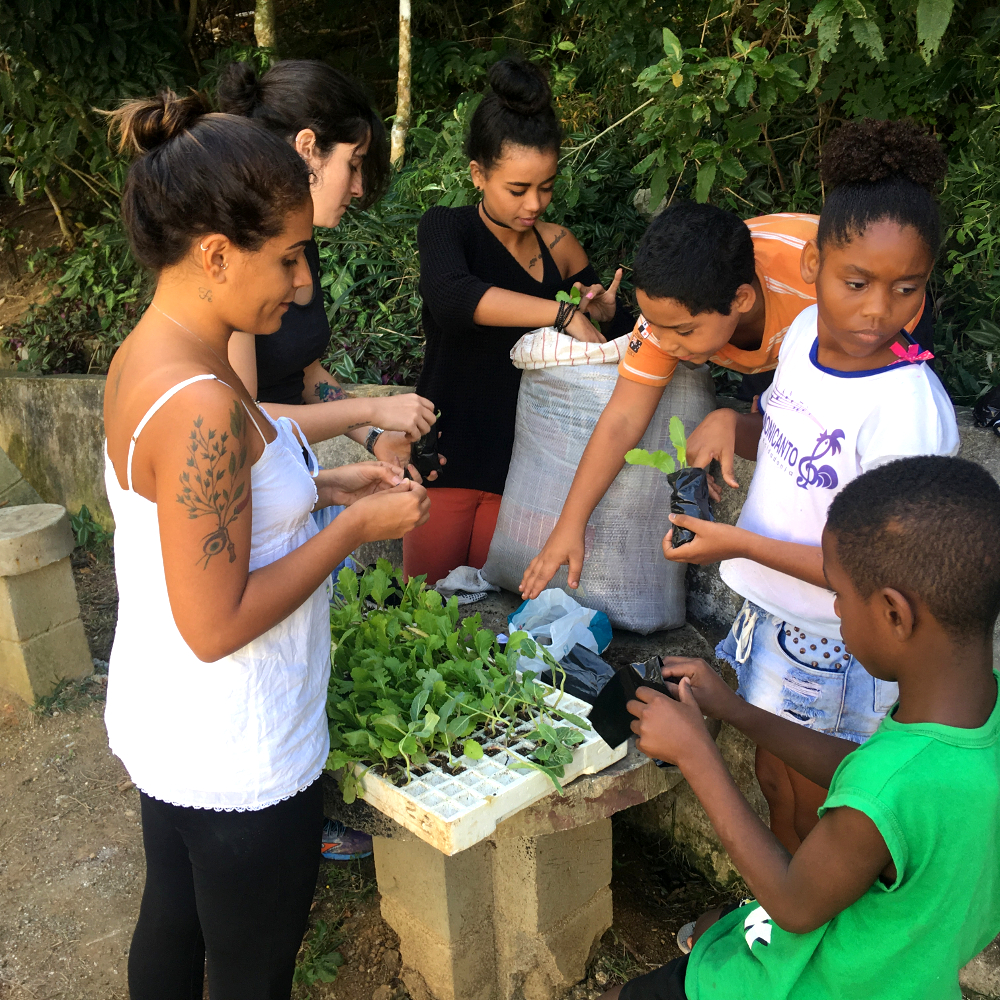
Planta na Rua volunteers show children in Cantagalo how to prepare seedlings (Thiago Camelo/Believe.Earth)
The horizontal organization of Planta na Rua, the division of the tasks and the democratic decision-making process, reflects its founder’s commitment to the principles of anarchism.
“I read a book called The Anarchist Doctrine Accessible to All, by José Oiticica, and I identified strongly with its content.”
“I have noticed that people who have to follow orders are always stressed and unhappy. I don’t want to be like that. I try not to push people or order them around, and I want people to act the same way with me, in my relationships, at Planta na Rua and so on.”
Earlier this year, Planta na Rua created a statement of principles, a proposal for a decentralized model for the creation of green spaces in Rio. The group has also forged ties with like-minded activists in Uberlândia, in the state of Minas Gerais, and the Distrito Federal in Central Brazil.
Telha is the one responsible for coordinating them. He’s working to identify local activists in those areas to speak publicly about the project, as well as to create and manage Facebook groups. Telha said he prefers to work with teachers, because they’re experienced at making arguments and mobilizing people.
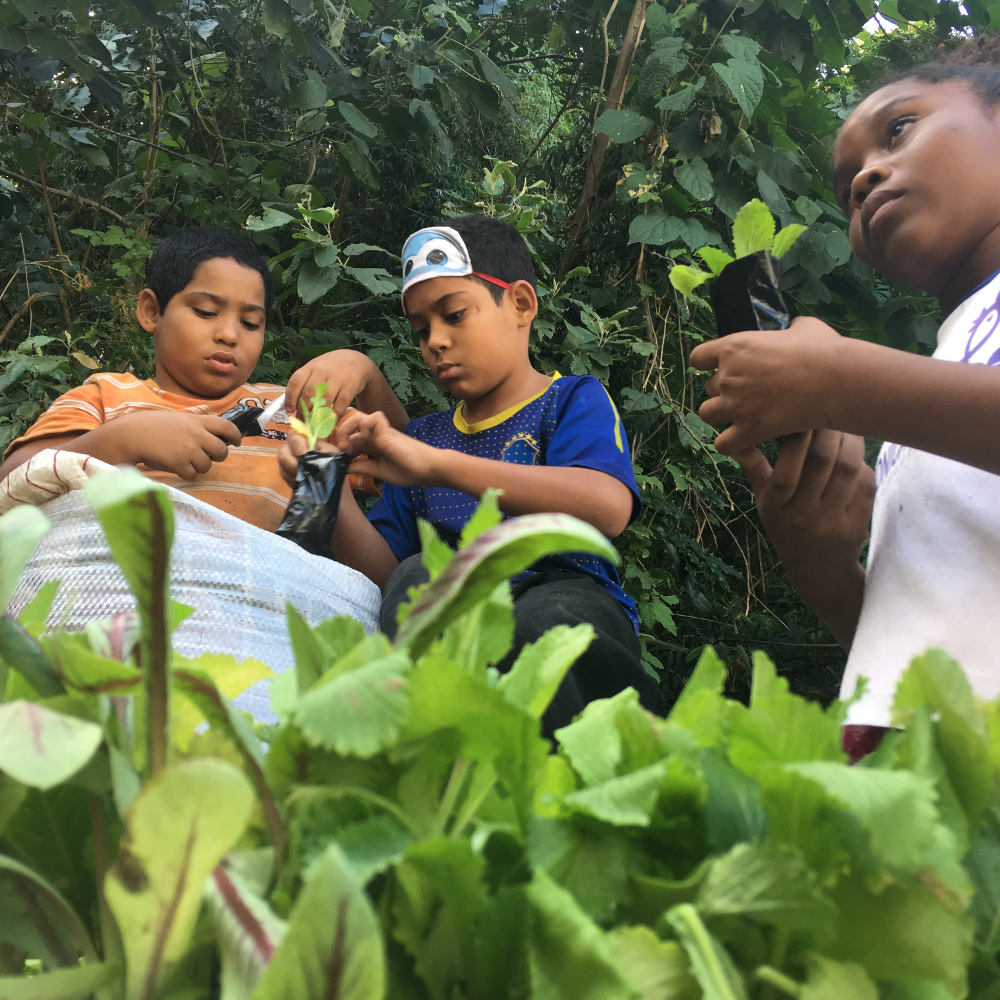
Children help to pack seedlings donated by the project to CIEP President João Goulart’s garden (Thiago Camelo/Believe.Earth)
MOBILIZED COMMUNITY
The prerequisite for adopting a public area and planting a garden, Telha said, is one or more people living in the immediate area who are committed to irrigation and maintenance. Sometimes those people are Planta na Rua volunteers, and sometimes they’re just local citizens who wish to revive a certain square, seedbed or empty lot.
“When we work with people,” Telha said, “we explain why a certain type of tree can or can’t be planted, we analyze the soil, we talk about the importance of planting native trees, we check if there are electrical wires nearby and determine the risk that the tree might touch a wire, and we clean away the garbage, to remove the risk of dengue fever.”
The group documents its past planting efforts on its Facebook page, including two recent outings in Olaria and Honório Gurgel, in northern Rio. Mono Telha appears in some of the videos and photos wearFing a green felt hat festooned with fruits, flowers and animal ornaments. That, he said, is his trick for attracting the attention of children and young people.
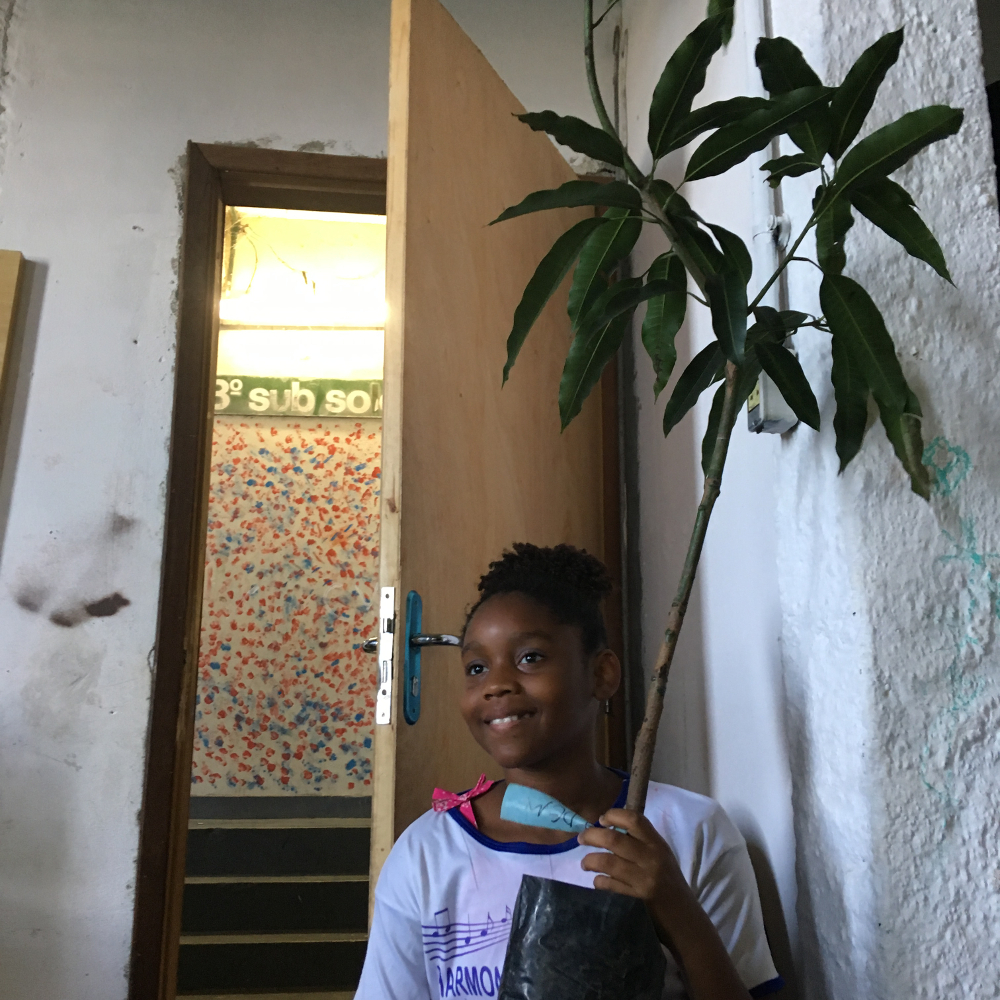
Larissa Cardoso, a resident of Cantagalo and a student of NGO Harmonicanto, with a seedling of mango tree donated by Planta na Rua (Thiago Camelo/Believe.Earth)
PARTNERSHIP WITH OTHER GROUPS
Believe.Earth caught up with Planta na Rua on Aug. 12, in Cantagalo, in the southern part of Rio. We met Mono Telha, who was wearing boots and his trademark hat. He was clearing soil with a hoe, working with a motley crew of volunteers.
They were at the Espaço Favela Hub, a community center in the area, preparing a space that will become a hydroponic garden and a fish pond.
On the same day, the group donated 200 fruit and vegetable plant seedlings to the future site of an irrigated garden, at the CIEP Presidente João Goulart public school.
The school is housed in a former hotel with a panoramic view of Ipanema Beach and the Rodrigo de Freitas Lagoon. The building is also home to a series of projects run by Viva Rio, a cultural nonprofit, such as Favela Hub and Harmonicanto Música and Citizenship, a music education program.
Diego Bastos, 34, a photographer who has taught workshops for children in the area, told Believe.Earth that he first started thinking about gardening when he was living in Spain, where, he said, the prevailing idea is that land must not go unused.
“They have a saying, “Greener, less concrete,” said Bastos, who is finalizing a documentary about neighborhoods that keep fruit and vegetable gardens.
Throughout the day, children from the community stopped by to learn how to prepare lettuce, mustard, basil, and other vegetable seeds. After teaching the volunteers, Telha, returning to his work, observed the kids sharing their newfound knowledge with one another.
For Telha, that’s “Mission accomplished.”
“I consider the community events to be a course in gardening and citizenship,” he said. “We have created a connection to the community through the revitalization of public space.”
